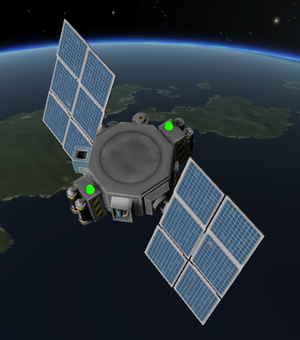Electric charge
| Electric charge | ||
| Density | None | |
| Transferable | Yes | |
| Tweakable | Yes | |
| Drainable | No | |
| Flow mode | Everywhere | |
| Cost | None | |
| Since version | 0.18 | |
Electric charge, also called electricity or energy, is a resource that is needed to operate various parts in the game. It is critical for unmanned spacecraft, which are generally uncontrollable without any electric charge. But manned spacecraft usually also need some electricity, because all command modules also require electricity for rotating the spacecraft.
Contents
Consumption and requisition
Electric charge can be obtained from solar panels, radiothermal generators, or dynamos built into certain engines. It can be stored in batteries to allow a vessel to operate when its primary sources are not available. Batteries are always fully charged at launch and gradually drain while the vessel's electricity consumption is greater than the amount produced by its active generating parts; they will recharge if a surplus of power is available.
Unmanned satellite cores constantly use 1.7 or 3.0 units of Electric Charge per minute but can only store enough internally for a few minutes of operation. Lights and sensors use small quantities of electricity when switched on. Ion engines, reaction wheels, and rover wheels require particularly large amounts of electricity to operate.
If a command pod has no electric charge available, the vessel becomes entirely nonfunctional and no parts may be operated (notably, this includes motorized solar panels which might have allowed it to recover).
Sources
Engines
| Engine type | Engine name | Power |
|---|---|---|
| Rocket Engines | LV-T30 Liquid Fuel Engine | 1.0/s |
| LV-T45 Liquid Fuel Engine | 1.0/s | |
| Rockomax "Poodle" Liquid Engine | 1.0/s | |
| Rockomax "Skipper" Liquid Engine | 2.0/s | |
| Rockomax "Mainsail" Liquid Engine | 2.0/s | |
| Jet Engines | Basic Jet Engine | 0.8/s |
| TurboJet Engine | 1.0/s |
Many rocket and jet engines can produce electricity. The exact output varies based on throttle level, and engines not running will not produce any electricity. The adjacent table shows the engines which provide electricity and their production at full throttle. Jet engines only generate electricity in Kerbin's or Laythe's atmosphere as they require oxygen to operate properly.
Solar panels
Solar panels are a lightweight source of electrical energy. However, they need direct sunlight to work, so they won't produce electricity on the night side of a planet, in the shadow of a spacecraft or during eclipses of the sun, although the craft is illuminated while in an eclipse. Due to this unreliability, it is recommended to have some energy storage as a buffer when supplying a craft solely with solar panels.
All panels except for the OX-STAT Photovoltaic Panels need to be extended using the right-click menu or action groups before they will generate energy. Unpacked solar panels are very fragile and will disintegrate when experiencing atmospheric drag, so they must be retracted during liftoff, aerobraking, or atmospheric re-entry.
The energy output of solar panels depends on their orientation to the sun. Except for the surface-mounted OX-STAT Photovoltaic Panel, all panels will automatically pivot around one axis to face the sun as much as possible. Reorienting a vessel to manually aim the panels at the sun and eliminate shadows cast on them will also improve power generation.
Generated power will also decrease with increasing distance from the Sun, but rather than following the real-life inverse-square law it experiences a spline curve of 3 piecewise cubics defined from 4 points:
| Distance (m) | Power | Notes |
|---|---|---|
| 0 | 10x | |
| 13,599,840,256 | 1x | Kerbin's orbit |
| 68,773,560,320 | 0.5x | Jool's semi-major axis |
| 206,000,000,000 | 0x | Almost 3x Jool's orbit |
Radioisotope thermoelectric generator
The PB-NUK Radioisotope Thermoelectric Generator is a constant and reliable source of energy which doesn't require any sunlight and is much more resistant to atmospheric drag than solar arrays. Unfortunately it has a very unpractical shape and is significantly heavier than solar panels with a comparable output of electricity.
Launch Clamps
TT18-A Launch Stability Enhancers provide attached craft with 1.0 charge units per second per clamp and thus prevent running out of energy on the launch pad.
Storage
Storing electric charge helps a craft survive longer without energy supply, deal with peak loads (such as the use of ion engines) or bridge time gaps when solar panels aren't usable. The following parts store energy:
- Unmanned command modules offer very low capacities and constantly consume energy.
- Manned command modules offer significant storage capacities and do not consume energy (unless they are rotating a spacecraft) but are relatively large and heavy.
- Batteries are small and offer high storage capacities at the same time.
- The Probodobodyne RoveMate functions like a large low-capacity battery.
All energy storage available to a craft is fully loaded at launch.
Batteries
The available batteries have all the same capacity/mass ratio of 50 g/E or 20 E/kg.
